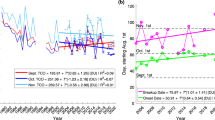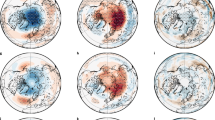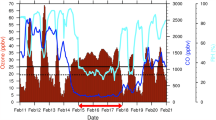Abstract
Depletion of stratospheric ozone in the Southern Hemisphere (SH) during the late twentieth century cooled local air temperature, which resulted in stronger stratospheric westerly winds near 60° S and altered SH surface climate. However, Antarctic ozone has been recovering since around 2001 thanks to the implementation of the Montreal Protocol, which banned production and consumption of ozone-depleting substances. Here we show that the post-2001 increase in ozone has resulted in significant changes to trends in SH temperature and circulation. The trends are generally of opposite sign to those that resulted from stratospheric ozone losses, including a warming of the SH polar lower stratosphere and a weakening of the SH stratospheric polar vortex. Observed post-2001 trends of temperature and circulation in the stratosphere are about 50–75% smaller in magnitude than the trends during the ozone depletion era. The response is broadly consistent with expectations based on modelled depletion-era trends and variability of both ozone and reactive chlorine. The differences in observed stratospheric trends between the recovery and depletion periods are statistically significant (P < 0.05), providing evidence for the emergence of dynamical impacts of the healing of the Antarctic ozone hole.
This is a preview of subscription content, access via your institution
Access options
Access Nature and 54 other Nature Portfolio journals
Get Nature+, our best-value online-access subscription
$29.99 / 30 days
cancel any time
Subscribe to this journal
Receive 12 print issues and online access
$259.00 per year
only $21.58 per issue
Buy this article
- Purchase on Springer Link
- Instant access to full article PDF
Prices may be subject to local taxes which are calculated during checkout






Similar content being viewed by others
Data availability
TOMS/OMI ozone data are available from https://ozoneaq.gsfc.nasa.gov/. ERA5 data are available from https://cds.climate.copernicus.eu/cdsapp#!/search?text=ERA5. MERRA2 data are available from https://disc.gsfc.nasa.gov/datasets?keywords=%22MERRA-2%22&page=1&source=Models%2FAnalyses%20MERRA-2. JRA55 data are available from https://rda.ucar.edu/datasets/ds628.1/. Model output from the ten-member ensembles used in the analysis presented here is available at https://doi.org/10.7910/DVN/YGWVSB. WACCM–CCMI and WACCM–CMIP6 model output are available from https://www.earthsystemgrid.org.
Code availability
Computer code is available from the corresponding author upon reasonable request.
References
Scientific Assessment of Ozone Depletion: 1998 Global Ozone Research and Monitoring Project Report 44 (WMO, 1999).
Randel, W. J. & Wu, F. Cooling of the Arctic and Antarctic polar stratospheres due to ozone depletion. J. Clim. 12, 1467–1479 (1999).
Thompson, D. W. J. & Solomon, S. Interpretation of recent Southern Hemisphere climate change. Science 296, 895–899 (2002).
Gillett, N. P. & Thompson, D. W. J. Simulation of recent Southern Hemisphere climate change. Science 302, 273–275 (2003).
Son, S. ‐W., Tandon, N. F., Polvani, L. M. & Waugh, D. W. Ozone hole and Southern Hemisphere climate change. Geophys. Res. Lett. 36, L15705 (2009).
Hendon, H. H., Thompson, D. W. J. & Wheeler, M. C. Australian rainfall and surface temperature variations associated with the Southern Hemisphere annular mode. J. Clim. 20, 2452–2467 (2007).
Renwick, J. A. & Thompson, D. W. J. The Southern Annular Mode and New Zealand climate. Water Atmos. 14, 24–25 (2006).
Rigby, M. et al. Increase in CFC-11 emissions from eastern China based on atmospheric observations. Nature 569, 546–560 (2019).
Solomon, S. et al. Emergence of healing in the Antarctic ozone layer. Science 353, 269–274 (2016).
Solomon, S. et al. Mirrored changes in Antarctic ozone and stratospheric temperature in the late 20th versus early 21st centuries. J. Geophys. Res. Atmos. 122, 8940–8950 (2017).
Scientific Assessment of Ozone Depletion: 2018 (WMO, 2018); https://www.esrl.noaa.gov/csd/assessments/ozone/2018/downloads/2018OzoneAssessment.pdf
Strahan, S. E. & Douglass, A. R. Decline in Antarctic ozone depletion and lower stratospheric chlorine determined from Aura Microwave Limb Sounder observations. Geophys. Res. Lett. 45, 382–390 (2018).
Shindell, D. T., Rind, D. & Lonergan, P. Increased polar stratospheric ozone losses and delayed eventual recovery owing to increasing greenhouse-gas concentrations. Nature 392, 589–592 (1998).
Son, S.‐W. et al. The impact of stratospheric ozone recovery on the Southern Hemisphere westerly jet. Science 320, 1486–1489 (2008).
Son, S.‐W. et al. Impact of stratospheric ozone on Southern Hemisphere circulation change: a multimodel assessment. J. Geophys. Res. 115, D00M07 (2010).
Banerjee, A. et al. A pause in Southern Hemisphere circulation trends due to the Montreal protocol. Nature 579, 544–548 (2020).
Lim, E.–P. et al. The 2019 Antarctic sudden stratospheric warming. SPARC Newsl. 54, 10–13 (2020).
Van Oldenborgh, G. J. et al. Attribution of the Australian bushfire risk to anthropogenic climate change. Nat. Hazards Earth Syst. Sci. 21, 941-960 https://doi.org/10.5194/nhess-21-941-2021 (2021).
Lim, E.–P. et al. Australian hot and dry extremes induced by weakenings of the stratospheric polar vortex. Nat. Geosci. 12, 896–901 (2019).
McPeters, R. D. et al. Earth Probe Total Ozone Mapping Spectrometer (TOMS) Data Products User’s Guide NASA/TP-1998–206895 (NASA, 1998).
McPeters, R. et al. Validation of the Aura Ozone Monitoring Instrument total column ozone product. J. Geophys. Res. 113, D15S14 (2008).
ERA5: Fifth Generation of ECMWF Atmospheric Reanalyses of the Global Climate (Copernicus Climate Change Service Climate Data Store, accessed 3 October 2019); https://cds.climate.copernicus.eu/cdsapp#!/home
Stone, K. A., Solomon, S. & Kinnison, D. E. On the identification of ozone recovery. Geophys. Res. Lett. 45, 5158–5165 (2018).
Kay, J. E. et al. The Community Earth System Model (CESM) Large Ensemble project: a community resource for studying climate change in the presence of internal climate variability. Bull. Am. Met. Soc. 96, 1333–1349 (2015).
Seviour, W. J. M. Weakening and shift of the Arctic stratospheric polar vortex: internal variability or forced response? Geophys. Res. Lett. https://doi.org/10.1002/2017GL073071 (2017).
Marsh, D. R. et al. Climate change from 1850 to 2005 simulated in CESM1(WACCM). J. Clim. 26, 7372–7391 (2013).
Garcia, R. R., Smith, A. K., Kinnison, D. E., de la Cámara, Á. & Murphy, D. J. Modification of the gravity wave parameterization in the Whole Atmosphere Community Climate Model: motivation and results. J. Atmos. Sci. 74, 275–291 (2017).
Solomon, S., Kinnison, D., Bandoro, J. & Garcia, R. Simulation of polar ozone depletion: an update. J. Geophys. Res. Atmos. 120, 7958–7974 (2015).
Calvo, N., Garcia, R. R. & Kinnison, D. E. Revisiting Southern Hemisphere polar stratospheric temperature trends in WACCM: the role of dynamical forcing. Geophys. Res. Lett. 44, 3402–3410 (2017).
Velders, G. J. M. & Daniel, J. S. Uncertainty analysis of projections of ozone-depleting substances: mixing ratios, EESC, ODPs, and GWPs. Atmos. Chem. Phys. 14, 2757–2776 (2014).
Kuttippurath, J., Bodeker, G. E., Roscoe, H. K. & Nair, P. J. A cautionary note on the use of EESC-based regression analysis for ozone trend studies. Geophys. Res. Lett. 42, 162–168 (2015).
Santer, B. D. et al. Statistical significance of trends and trend differences in layer-average atmospheric temperature time series. J. Geophys. Res. 105, 7337–7356 (2000).
Kobayashi, S. et al. The JRA-55 reanalysis: general specifications and basic characteristics. J. Meteor. Soc. Japan 93, 5–48 (2016).
Gelaro, R. et al. The Modern-Era Retrospective Analysis for Research and Applications, version 2 (MERRA-2). J. Clim. 30, 5419–5454 (2017).
Seviour, W. J., Waugh, D. W., Polvani, L. M., Correa, G. J. P. & Garfinkel, C. L. Robustness of the simulated tropospheric response to ozone depletion. J. Clim. 30, 2577–2585 (2017).
Zambri, B. et al. Modeled and observed volcanic aerosol control on stratospheric NOy and Cly. J. Geophys. Res. Atmos. https://doi.org/10.1029/2019JD031111 (2019).
Yuval, J. & Kaspi, Y. Eddy activity sensitivity to changes in the vertical structure of baroclinicity. J. Atmos. Sci. 73, 1709–1726 (2016).
Fu, Q. S., Solomon, S., Pahlavan, H. A. & Lin, P. Observed changes in the Brewer–Dobson circulation for 1980–2018. Envir. Res. Lett. 14, 114026 (2019).
Smith, D. M. et al. Robust skill of decadal climate predictions. NPJ Clim. Atmos. Sci. 2, 13 (2019).
Bandoro, J., Solomon, S., Donohoe, A., Thompson, D. W. J. & Santer, B. Influences of the Antarctic ozone hole on Southern Hemisphere summer climate change. J. Clim. 27, 6245–6264 (2014).
Simmons, A. et al. Global Stratospheric Temperature Bias and Other Stratospheric Aspects of ERA5 and ERA5.1 Technical Memorandum No. 859 (ECMWF, 2020); https://ecmwf.int/node/19362
Hurrell, J. W. et al. The Community Earth System Model: a framework for collaborative research. Bull. Am. Meteorol. Soc. 94, 1339–1360 (2013).
Kinnison, D. E. et al. Sensitivity of chemical tracers to meteorological parameters in the MOZART3 chemical transport model. J. Geophys. Res. 112, D20302 (2007).
Tilmes, S. et al. Representation of the Community Earth System Model (CESM1) CAM4-Chem within the chemistry–climate model initiative. Geosci. Model Dev. 9, 1853–1890 (2016).
Matthes, K. et al. Role of the QBO in modulating the influence of the 11 year solar cycle on the atmosphere using constant forcings. J. Geophys. Res. 115, D18110 (2010).
Mills, M. J. et al. Global volcanic aerosol properties derived from emissions, 1990–2014, using CESM1(WACCM). J. Geophys. Res. Atmos. 121, 2332–2348 (2016).
Neely, R.R. III & Schmidt, A. VolcanEESM: Global Volcanic Sulphur Dioxide (SO2) Emissions Database from 1850 to Present—Version 1.0 (Centre for Environmental Data Analysis, 2016); https://doi.org/10.5285/76ebdc0b-0eed-4f70-b89e-55e606bcd568
Fujino, J., Nair, R., Kainuma, M., Masui, T. & Matsuoka, Y. Multi‐gas mitigation analysis on stabilization scenarios using AIM global model. Energy J. https://doi.org/10.5547/ISSN0195-6574-EJ-VolSI2006-NoSI3-17 (2006).
Hijioka, Y., Matsuoka, Y., Nishimoto, H., Masui, M. & Kainuma, M. Global GHG emissions scenarios under GHG concentration stabilization targets. J. Glob. Environ. Eng. 13, 97–108 (2008).
Eyring, V. et al. Overview of IGAC/SPARC Chemistry–Climate model initiative (CCMI) community simulations in support of upcoming ozone and climate assessments. SPARC Newsl. 40, 48–66 (2013).
Deser, C. et al. Insights from Earth system model initial-condition large ensembles and future prospects. Nat. Clim. Change 10, 277–286 (2020).
Gettelman, A. et al. The Whole Atmosphere Community Climate Model version 6 (WACCM6). J. Geophys. Res. Atmos. 124, 12380–12403 (2019).
Deser, C., Philips, A. S., Alexander, M. A. & Smoliak, B. V. Projecting North American climate over the next 50 years: uncertainty due to internal variability. J. Clim. 27, 2271–2296 (2014).
Andrade, J. M. & Estévez–Pérez, M. G. Statistical comparison of the slopes of two regression lines: a tutorial. Anal. Chim. Acta 838, 1–12 (2014).
Acknowledgements
Helpful discussion and comments by D. Kim are gratefully acknowledged. B.Z. and S.S. were supported by grants from the National Science Foundation NSF 1539972 and 1848863, and a gift to MIT from an anonymous donor. D.W.J.T. is supported by NSF AGS-1848785. Q.F. is supported by NSF AGS‐1821437. We would like to acknowledge high-performance computing support from Cheyenne (https://doi.org/10.5065/D6RX99HX) provided by NCAR’s Computational and Information Systems Laboratory, sponsored by the National Science Foundation.
Author information
Authors and Affiliations
Contributions
B.Z. and S.S. designed the study. B.Z., S.S., D.W.J.T. and Q.F. analysed and interpreted the results. B.Z. led the writing, and all authors contributed to the editing of the manuscript and approved the final version.
Corresponding author
Ethics declarations
Competing interests
The authors declare no competing interests.
Additional information
Peer review information Nature Geoscience thanks Sabine Bischof, Olaf Morgenstern, Yousuke Yamashita and the other, anonymous, reviewer(s) for their contribution to the peer review of this work. Primary Handling Editors: Clare Davis, Tom Richardson.
Publisher’s note Springer Nature remains neutral with regard to jurisdictional claims in published maps and institutional affiliations.
Extended data
Extended Data Fig. 1 Trends and trend differences for different turnaround years.
Ozone and circulation trends for ozone depletion era (filled circles), ozone recovery era (open circles), and their differences (squares) for turnaround year defined as (a–d) 1999, (e–h) 2000, (i–l) 2001, and (m–p) 2002. Vertical lines indicate the 95% confidence intervals on the trends.
Extended Data Fig. 2 GHG contribution to WACCM geopotential height trends.
WACCM ensemble mean geopotential height trends (m/decade) for 2001–2018 for (a) ODS+GHG, (b) GHG-only, and (c) the difference (approximately the ODS-only response).
Extended Data Fig. 3 ODS-forced trends.
As Fig. 6, but for ODS+GHG minus GHG-only.
Extended Data Fig. 4. WACCM-CMIP6 trend differences.
WACCM-CMIP6 November-December Southern Hemisphere trend differences between 1979–2001 and 2001-2018 in ozone, temperature, and geopotential height. Hatching indicates regions where the trend differences are not significantly different from the distributions of trend differences in the control run (p > 0.05; Methods).
Extended Data Fig. 5 WACCM CCMI and CMIP6 temperature trends.
SH ND WACCM ensemble mean zonal-mean temperature trends for CCMI (a, c) and CMIP6 (b, d) for the ozone depletion (a, b) and recovery (c, d) periods. Hatching indicates regions where the trend differences are not significantly different from the distributions of trend differences in the control runs (p > 0.05; Methods).
Extended Data Fig. 6
WACCM-CCMI temperature trends. SH ND zonal-mean temperature trends for the WACCM-CCMI ensemble mean calculated using (a,d) linear regression, equation 1, (b,e) equation 2 using scaled differences over 10 year periods, and (c,f) the difference for the periods (a–c) 1975–2001 and (d–f) 2001–2018 using the two methods.
Extended Data Fig. 8 Trend differences arising from trend calculation methods: the role of ensemble size.
SH ND zonal-mean temperature trend shown in each panel is the difference between using the linear trend (for example, as in Extended Data Fig. 6a) and differencing the climatologies (for example, as in Extended Data Fig. 6b) for the average of 1 ≤ n ≤ 9 ensemble members (the difference for n = 10 is shown in Extended Data Fig. 6c).
Extended Data Fig. 9 JRA55 temperature trends.
SH ND zonal-mean temperature linear trends for JRA55 for (a) 1975–2001, (b) 1979–2001, and (c) the difference.
Rights and permissions
About this article
Cite this article
Zambri, B., Solomon, S., Thompson, D.W.J. et al. Emergence of Southern Hemisphere stratospheric circulation changes in response to ozone recovery. Nat. Geosci. 14, 638–644 (2021). https://doi.org/10.1038/s41561-021-00803-3
Received:
Accepted:
Published:
Issue Date:
DOI: https://doi.org/10.1038/s41561-021-00803-3
This article is cited by
-
Warmer Antarctic summers in recent decades linked to earlier stratospheric final warming occurrences
Communications Earth & Environment (2024)
-
Potential drivers of the recent large Antarctic ozone holes
Nature Communications (2023)
-
Role of Stratospheric Processes in Climate Change: Advances and Challenges
Advances in Atmospheric Sciences (2023)
-
Stratospheric ozone, UV radiation, and climate interactions
Photochemical & Photobiological Sciences (2023)
-
A broadscale shift in antarctic temperature trends
Climate Dynamics (2023)



